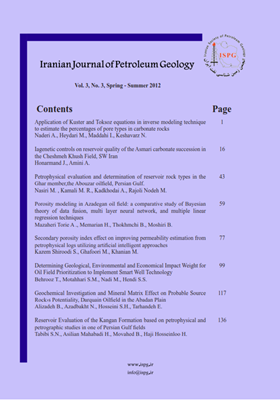Iagenetic controls on reservoir quality of the Asmari carbonate succession in the Cheshmeh Khush Field, SW Iran
Subject Areas :جواد هنرمند 1 , عبدالحسین امینی 2
1 -
2 - University of Tehran
Keywords: Diagenesis reservoir quality Asmari Cheshmeh Kush oil field ,
Abstract :
The Oligo-miocence Asmari Formation in the Cheshmeh Kush Oil Field consists of a mixed carbonate-siliciclastic succession. The carbonate intervals of the Formation display a high degree of vertical heterogeneity created by a complex diagenetic history. This study is aimed to investigate the effect of diagenetic events on reservoir quality of carbonate intervals of the Asmari Formation. Core samples and thin sections were studied from sedimentological and diagenetic point of view. Results from cathodoluminesence and scanning electron microscopy were used to investigate diagenetic features in details. Core analysis data (porosity and permeability) and wire-line logs (porosity and oil saturation values) from studied interval were used in order to examine reservoir properties. Diagenetic studies and their comparison with petrophysical data demonstrated that dolomitization, cementation (calcite, anhydrite and celestite cements), compaction and dissolution are the most important diagenetic events affecting porosity and permeability of the reservoir. Based on vertical distribution of diagenetic features and reservoir characteristics, diagenetic zones (DZ) of the carbonate succession were introduced. Medium crystalline dolostones with sparse compaction features and limited anhydrite cement (DZ-23, 27 and 30) comprise the highest value of porosity and permeability. Whereas intense mechanical and chemical compaction and evaporate (anhydrite and celestite) cementation in some dolomitic intervals have thoroughly reduced reservoir quality (DZ-12, 11 and 24). Compaction and calcite cementation (coarse spary, equant and poikilotopic types) in some limestone intervals damaged reservoir properties and created non-reservoir intervals (DZ-3, 20 and 17). In contrast, high value of interparticle and dissolution porosities along with minor compaction and cementation effects has improved reservoir properties of the Asmari limestones (DZ-31 and 32). This study shows that the reservoir characteristics of the Asmari Formation in the studied field are dominantly affected by diagenetic events and therefore diagenetic studies and determination of diagenetic zones in field-scale are the most important part in static reservoir modeling and


